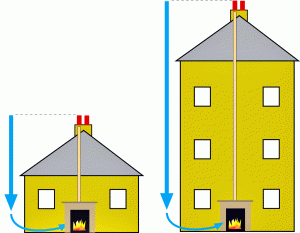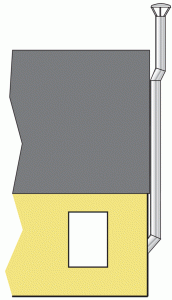
A tall chimney applies more air-pressure to its base than a short one. All things being equal the chimney in the tall building at right will generate a stronger, more stable draught than the short chimney in the lower building.
A short chimney of the type often installed into chalets, mobile homes and top floor sitting rooms may struggle to generate adequate draught particularly when flue gas temperatures are low, as is the case when a stove is run at reduced output.
 Note that whenever height is added to a chimney the likely impact on temperature must always be taken into account. In the building at right, adding height has caused the chimney to stick up like a flagpole in a way that will cause its upper section to run cold. In such cases the benefits of extra height may well be cancelled out by excessive heat-loss from the exposed section. In addition, any chimney that runs cold at its upper extremity is likely to foul up rapidly owing to the large volumes of condensate produced.
Note that whenever height is added to a chimney the likely impact on temperature must always be taken into account. In the building at right, adding height has caused the chimney to stick up like a flagpole in a way that will cause its upper section to run cold. In such cases the benefits of extra height may well be cancelled out by excessive heat-loss from the exposed section. In addition, any chimney that runs cold at its upper extremity is likely to foul up rapidly owing to the large volumes of condensate produced.
 The flue gases fed to a chimney should be hot enough to promote an adequate draught and must be kept as hot as possible until they exit at the top. This is best achieved by constructing the chimney in lightweight insulated materials that heat up rapidly. The chimney should also be contained within the warmth and shelter of the building for as much of its length as possible. Twin wall sectional chimneys use just 25mm of insulation so it is particularly important to minimise their exposure to the elements. Clearly the situation shown at right is undesirable and should be avoided.
The flue gases fed to a chimney should be hot enough to promote an adequate draught and must be kept as hot as possible until they exit at the top. This is best achieved by constructing the chimney in lightweight insulated materials that heat up rapidly. The chimney should also be contained within the warmth and shelter of the building for as much of its length as possible. Twin wall sectional chimneys use just 25mm of insulation so it is particularly important to minimise their exposure to the elements. Clearly the situation shown at right is undesirable and should be avoided.
Any masonry chimney is by definition ‘stone cold’ and will quickly chill hot flue gases fed to it. The best way to counter this is to fit a low-mass flexible liner which heats up rapidly and helps to keep the flue gases hot throughout its length.
To find the best stove for your requirements you will need to consider various questions. Your stove should be chosen with due consideration given to the size of space the stove is being asked to heat. To this you need to add any other personal requirements such as whether you want it to do any water heating, what the installation requirements might be, aesthetic preference, etc.
For more in depth information please see our 1st Time Buyers Guide which gives a more detailed breakdown of the important areas to consider.
